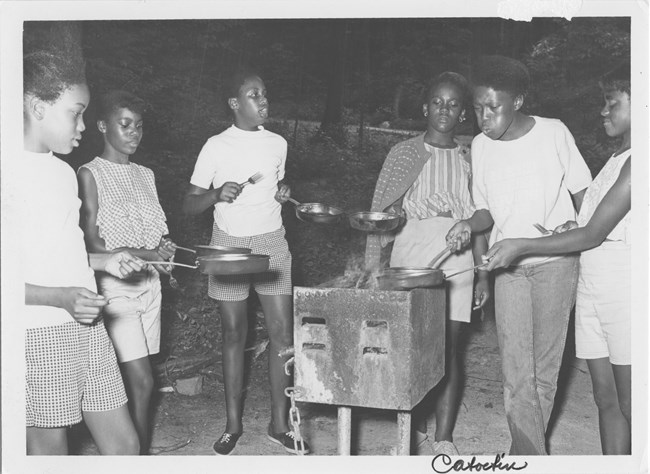Last updated: March 17, 2023
Article
Summer in the Parks (1968-1976)

NPS
Overview
Summer in the Parks was a popular program in Washington, DC, area national parks that connected people to the parks through arts and recreation. The program ran from 1968 to 1976.
Building on an early plan to bus youths to Catoctin Mountain Park and Prince William Forest Park, National Park Service (NPS) Director George Hartzog opened the Office of Urban Affairs and started a transportation program in 1966. In 1967, Congress appropriated funds for the NPS to expand the program and provide activities in the District of Columbia the following summer. But before those plans came to fruition, Martin Luther King, Jr. was assassinated, which triggered a rash of violence, arson, and looting in Washington, DC, in the spring of 1968. After the riots, the program took on a new meaning as a way to help heal a troubled city.

NPS
Programs
Summer in the Parks featured three major themes of programming:
- Surprise trips were field trips to parks. The first summer, these trips bussed youth to Rock Creek Park, Fort Washington, Great Falls, Kenilworth Aquatic Gardens, Oxon Hill Farm, the National Zoo, and C&O Canal. Later, the trips expanded to Catoctin Mountain Park in Maryland.
- Community parks programs were hosted in neighborhood parks and included games, arts, and crafts for kids.
- Spectaculars were large outdoor concerts and shows that brought the city together.
The first summer alone, "Surprise Trips" involved 40,000 children. The "Community Parks" initiative held 100 concerts, 130 movies, and had dance groups give over 100 performances, all in neighborhood parks. Spectaculars kicked off with an audience of 20,000 at Meridian Hill to see Pearl Bailey and Cab Calloway. By the end of the summer more than 300,000 people made trips to events held throughout the city.

NPS
Outcomes
The program reinvented how the NPS engaged with Washington, DC, communities: it involved community organizations in planning, hired locally, and designed activities to meet community needs, from improving children’s literacy to creating hit concert series.
Summer in the Parks helped birth a music scene in DC, giving young performers a place to learn and innovate. Summer in the Parks helped give rise to the go-go and punk music scenes in DC. In a 2017 interview, Greg "Sugar Bear" Elliott said, "To me, Summer in the Park[s] was a birthplace of a lot of go-go history because that's where you got the most exposure...When you [are] performing and you see a crowd bobbing their head or clapping or dancing or whatever, that's like a high you can't buy."
Some of Summer in the Parks programs have persisted to the present day including the Fort Dupont Summer Concert Series, the Hispanic Heritage Festival, and more. These programs continue to draw crowds year after year.
Further Reading
Garland-Jackson F and Lattanzi Shutika D. 2020. Summer in the Parks (1968-1976); A Special Ethnohistory Study. NCRO 800 174935ATags
- anacostia park
- catoctin mountain park
- chesapeake & ohio canal national historical park
- fort dupont park
- fort washington park
- george washington memorial parkway
- great falls park
- kenilworth park & aquatic gardens
- national capital parks-east
- national mall and memorial parks
- oxon cove park & oxon hill farm
- the white house and president's park
- prince william forest park
- rock creek park
- dc
- civil rights
- history
- youth
- youth activities
- summer in the parks
- programs
- district of columbia
- ncr
- anthropology
